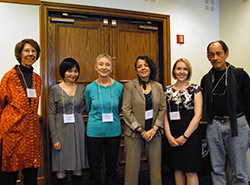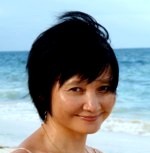Everything Communicates
What do an online weight-loss discussion board, a state commission hearing on hydrofracking and a job interview all have in common?
Language – and not only words, but the way people use them, the gestures they use when communication includes a visual component, and how all these details affect what the participants take away from the encounter.
The broader term for these kinds of language behaviors is “naturally occurring interaction,” and the community of scholars who study them spans a broad range of fields. Yet historically that community has lacked what Hansun Zhang Waring, TC Associate Professor of Applied Linguistics, calls an “agora,” or central gathering place where all those using different theories and analytic tools could share and learn from one another’s work.
“As a researcher, I craved it and wanted it for my doctoral students,” says Waring.
So she started LANSI – the Language and Social Interaction Working Group, which gathers researchers from the New York area to work together on data once a month, and scholars from around the country and overseas for an annual, two-day conference at TC.
LANSI’s third conference, held this past fall, drew more than 80 scholars from as far away as Belgium, the Netherlands and Japan. In two dozen sessions, researchers shared their work, discussed methods, and fielded questions and comments on the hidden dynamics of interactions in a wide range of settings.
At issue were data on word choice, question-and-answer sequences, and behaviors such as pauses and hesitations, smiles, body language and physical placement in a room. Researchers shared transcript excerpts and samples of audio and video recording to illustrate their work.
“We ask two questions,” said Sandra Thompson, Research Professor of Linguistics at the University of California at Santa Barbara, who shared research from a forthcoming book on responsive actions. “First, how do everyday social interactions motivate the grammar of a language? And second, how do we understand grammar as being both cognitive and social – in other words, how can a linguistic form be both stored in our heads, and shaped by interaction?”
Thompson showed examples of how people both make and respond to requests – using, for example, brief and clipped responses versus longer, more detailed ones – partly in function of the relative authority of each party, and whether, for instance, they think they are entitled to an answer, or they are concerned that they might not receive one.
The patterns show that grammar is not just a set of learned rules and customs. “Grammar is what becomes ritualized from social interactions – from a loosely organized set of richly and complexly understood memories,” Thompson said.
Gabriele Kasper, Professor in the Department of Second Language Studies at the University of Hawai’i at Mānoa, looked at a specific dynamic that can occur in the interaction between an interviewer and an interviewee. Researchers know that the degree of common experience between the two – for instance, whether they belong to the same self-identified ethnic or cultural community – shapes the way an interview unfolds. But they know less about what happens when the shared belonging – or the absence of shared belonging – becomes itself a topic in the interview.
“How do commonalities between the interviewer and the interviewee become concerns for the interview participants themselves?” Kasper asked. She illustrated the question with transcripts and audio clips from autobiographic research interviews held with first- and second-generation immigrants.
In the closing plenary, Doug Macbeth, Associate Professor in the Department of Educational Studies at Ohio State University, took a sociological approach. He reviewed the history of the field of sequential analysis, and the way transcripts became its primary tool, followed by other complementary tools such as video recordings. But Macbeth argued that for all the wealth of tools, researchers should not forget that the “first analyst” is already in the room: in other words, participants in the interaction are themselves analyzing it in real time, and through their own reactions and behaviors.
Among the examples he presented was a classroom in which a teacher enters and starts a sentence but does not complete it – not because she has forgotten the end, but as a cue for the students to spontaneously shush each other and grow quiet. In another case, several people are having a discussion and one speaks a long time; in response another keeps making gestures that show she wants to jump in.
“The parties are the analyst too,” Macbeth said. “In classroom studies, sequential analysis is most useful when it returns us to the first analyst on the scene. Our task is to write detailed descriptions of worlds already engaged.”
Several times during the two-day event, Waring said, she heard the meeting described as a “boutique conference” – confirmation that she had indeed provided an agora for her colleagues. “I guess that means it’s small, high-end, and high-quality.”Published Tuesday, Jan. 21, 2014

